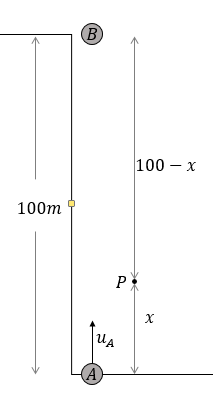
A stone is allowed to fall from the top of a tower of height 100m and at the same time, another stone is projected vertically upwards from the ground with a velocity of 25m/s. Calculate when and where the two stones will meet.
Answer
517.7k+ views
Hint: The point of collision can be considered as $x$ and the time of the collision as $t$. Then we can find $x$ and $t$ using the two sets of data given. We can simplify things by realizing that there is no relative acceleration between the two stones.
Complete step by step answer:
Let us say that the two stones hit each other at a distance $x$ above the ground at time $t$. Also, let us say this point of collision is P.

For stone $A$ to reach$P$, it travelled upwards with a constant downward acceleration. So the displacement $x$ and time $t$ is related as $x = {u_A}t - \dfrac{1}{2}g{t^2}$ …(1)
Here g is the acceleration due to gravity and ${u_A}$ is the initial upwards velocity given.
Similarly, for the stone dropped from the top, it has no downward initial velocity but only a downward acceleration. Also, we know the tower is 100m high. So if stone A had travelled $x$ distance, stone B should have travelled $100 - x\;m$. So the displacement of stone $B$ is given as :
$100 - x = \dfrac{1}{2}a{t^2}$ …(2)
Now, let us add equations (1) and (2).
$100 - x + x = {u_A}t + \dfrac{1}{2}a{t^2} - \dfrac{1}{2}a{t^2}$
$100 = {u_A}t$
Let us now substitute the values of ${u_B}$ and ${u_A}$ to get the time taken.
$100 = (25)t$
$t = \dfrac{{100}}{{25}} = 4s$
Now, the position of collision, $x$ can be found by substituting the value of $t$ obtained in equation (1)
$x = 25 \times 4 - \dfrac{1}{2} \times 9.8 \times {\left( 4 \right)^2}$
$x = 100 - 78.4 = 21.6m$
Note: Here, both objects experience the same acceleration of $g$ in the same direction. So we can say that there is no relative acceleration between the two stones. So from stone A's perspective, stone B is approaching with zero acceleration (constant speed).
Here since the relative velocity of stone A with respect to stone B is ${u_B} - {u_A} = 0 - 25 = - 25m/s$ towards stone B. With this in mind, we can easily calculate the time of the collision. We have two bodies approaching each other at $125m/s$ with $100m$ separation. The time taken to collide would be \[t = \dfrac{{{\text{distance}}}}{{{\text{speed}}}} = \dfrac{{100}}{{25}} = 4s\].
Complete step by step answer:
Let us say that the two stones hit each other at a distance $x$ above the ground at time $t$. Also, let us say this point of collision is P.

For stone $A$ to reach$P$, it travelled upwards with a constant downward acceleration. So the displacement $x$ and time $t$ is related as $x = {u_A}t - \dfrac{1}{2}g{t^2}$ …(1)
Here g is the acceleration due to gravity and ${u_A}$ is the initial upwards velocity given.
Similarly, for the stone dropped from the top, it has no downward initial velocity but only a downward acceleration. Also, we know the tower is 100m high. So if stone A had travelled $x$ distance, stone B should have travelled $100 - x\;m$. So the displacement of stone $B$ is given as :
$100 - x = \dfrac{1}{2}a{t^2}$ …(2)
Now, let us add equations (1) and (2).
$100 - x + x = {u_A}t + \dfrac{1}{2}a{t^2} - \dfrac{1}{2}a{t^2}$
$100 = {u_A}t$
Let us now substitute the values of ${u_B}$ and ${u_A}$ to get the time taken.
$100 = (25)t$
$t = \dfrac{{100}}{{25}} = 4s$
Now, the position of collision, $x$ can be found by substituting the value of $t$ obtained in equation (1)
$x = 25 \times 4 - \dfrac{1}{2} \times 9.8 \times {\left( 4 \right)^2}$
$x = 100 - 78.4 = 21.6m$
Note: Here, both objects experience the same acceleration of $g$ in the same direction. So we can say that there is no relative acceleration between the two stones. So from stone A's perspective, stone B is approaching with zero acceleration (constant speed).
Here since the relative velocity of stone A with respect to stone B is ${u_B} - {u_A} = 0 - 25 = - 25m/s$ towards stone B. With this in mind, we can easily calculate the time of the collision. We have two bodies approaching each other at $125m/s$ with $100m$ separation. The time taken to collide would be \[t = \dfrac{{{\text{distance}}}}{{{\text{speed}}}} = \dfrac{{100}}{{25}} = 4s\].
Recently Updated Pages
Why are manures considered better than fertilizers class 11 biology CBSE

Find the coordinates of the midpoint of the line segment class 11 maths CBSE

Distinguish between static friction limiting friction class 11 physics CBSE

The Chairman of the constituent Assembly was A Jawaharlal class 11 social science CBSE

The first National Commission on Labour NCL submitted class 11 social science CBSE

Number of all subshell of n + l 7 is A 4 B 5 C 6 D class 11 chemistry CBSE

Trending doubts
1 Quintal is equal to a 110 kg b 10 kg c 100kg d 1000 class 11 physics CBSE

Why is steel more elastic than rubber class 11 physics CBSE

What is boron A Nonmetal B Metal C Metalloid D All class 11 chemistry CBSE

What is Environment class 11 chemistry CBSE

Bond order ofO2 O2+ O2 and O22 is in order A O2 langle class 11 chemistry CBSE

How many squares are there in a chess board A 1296 class 11 maths CBSE




